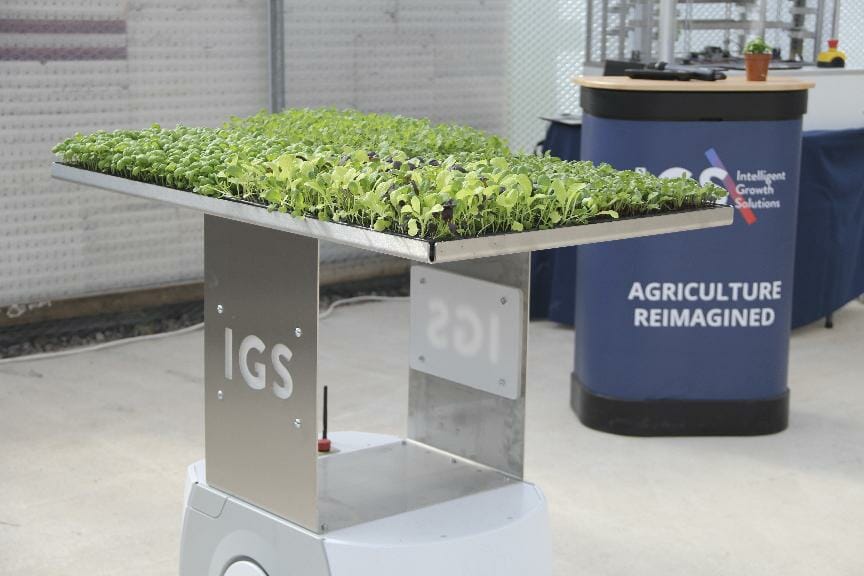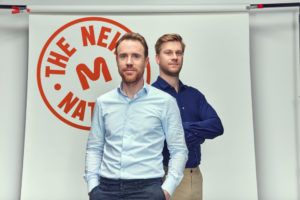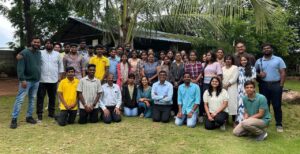Editor’s Note: Intelligent Growth Solutions (IGS) is a portfolio company of AgFunder’s and recently attracted investment from leading agtech investor Ospraie. IGS offers plug and play vertical farming technology to vertical farm operators, which they say can increase efficiencies and substantially reduce costs compared to other vertical farming operations. It can be hard to explain exactly how the technology does this, so we caught up with Niall Skinner, lead mechanical engineer at IGS to get an in-depth explanation of how the tech works.
What core challenges facing the vertical farming market does the IGS technology address, and how?
While vertical farming is not the ultimate solution to the world’s farming challenges, it does give control over many variables or, perhaps more accurately, the weather. At IGS we have gone back to basics in our technological approach to make weather control a reality, building four families of patents and patents pending along the way.
We recognised that running a vertical farm needs to be simple, even if the technology behind it is not! By its very design, a vertical farm is often a far more technical and complex environment than a traditional farm or even glasshouse environment would be. An overly technical system can, however, be off-putting, so we have turned the thinking on its head: there are no computers, cables or capacitors in our systems.
We thought outside the box (quite literally) to work out how to bring weather from the outside in, and allow it to be controlled through a mobile phone app. Our ‘plug and play’ modular systems address the challenges of power and labour costs and offer opportunity to pre-programme ‘weather recipes’ to ensure maximum productivity across yield, consistency and quality. Core to our R&D efforts was to ensure greater commercial viability for operators and the focus on power reducing technology and automation has been paramount. Our approach has enabled us to demonstrate clearly reductions of up to 50% power usage and 80% labour costs.
In addition to our power management capabilities, we are particularly excited about our patents that address the serious challenge of ventilation in a closed space. Keeping crops at an even temperature under hot lights while balancing the CO2 they inhale and the oxygen the exhale is very tricky, but our patent-pending (in this case) technology provides a solution that delivers the required balance, even as it captures, condenses and reuses the water vapour the plants emit.
Can you explain in more detail how your technology can reduce power consumption in a vertical farm
We have developed a power-management platform that flexes with the grid in real-time, allowing it to respond to external impacts such as grid stability and power availability. This means that power can be pulled when it is cheaper or pushed back when it is more expensive and in-demand: in effect, it imitates the role of a large battery where the excess energy is converted into grown produce. The use of industrial Omron SYSMAC programmable logic controllers (PLCs) to automate our system allows automatic recovery from power loss events and means that individual towers and sites get the power they need. As a result, none of the systems need to be reset, reprogrammed or manually repositioned.
Our system has a baseline power consumption of 60 kilowatts (kW), which can be rapidly increased to 105 kW or reduced to 30 kW for short periods to optimise grid stability. Other drains on power include heating and air conditioning, but all our systems including watering are on closed loop systems to minimise power consumption. Our design reduces the need for HEPA (high-efficiency particulate air) filtration to clean large volumes of incoming air, and the heating and/or cooling of this air depending on location and season – all of which are a drain on power. In combination these efficiencies contribute to a power-saving of 50%.
With over 1000 LEDs per tray, lighting forms over two-thirds of the system’s power requirements. We were determined to develop a more efficient system to drive the LEDs, and this is where the three-phase power supply design was born. This system is more commonly used to power machinery in an industrial environment but works by transferring the power supply to a safe voltage level and transmitting it to each individual tray within the tower using aluminium tubes rather than cables. By using tubes rather than cables, we can improve transmission efficiency. Aluminium tubes are also much cheaper and lighter than comparable copper cables. By using three-phase power at a tray level, we can also further reduce losses of power and provide inherent phase balancing. This eliminates the need for costly and inefficient filtering and power factor correction, as well as the use of capacitors for single-phase conversion. These measures contribute to an increase of between 5% and 10% in driver efficiency,
Your approach to the technology replicates a more industrialised environment – why is that?
Initially, when the founding team of engineers came together at IGS, the background was more heavily based in industrial operations. This has actually been a considerable advantage in helping us look differently at the vertical farming environment; it is our industrial environment approach this is key to this. We operate our farms in large steel frame warehouses with insulated cladding walls to provide isolation from the external environment. For example, the standard buildings are 10 metres in height, which allows up to 26 trays to be stacked in towers up to 9 metres high, but we do offer a range of options in addition to this. It really is closer in style to an industrial unit than a more traditional agricultural setting; handling the trays in this environment requires no human involvement whatsoever. It is here we generate savings of as much as 80% in the area of labour.
Within each tower, we have established standalone ventilation and irrigation closed-loop systems, which automatically sterilise and recycle air and water so that the only regular inputs the system needs are power, seed, nutrients, carbon dioxide and harvested rainwater. The air is sterilised by UV filtration technology – similar to that used in clean rooms. Standard industrial chillers and cooling coils cool and dehumidify the air which is then heated as needed, also drawing on waste heat from multiple areas in the facility. Carbon dioxide can be added to this loop when required too. This optimised management right across the components of our system when compared with conventional and glasshouse environments contribute to an overall reduction of power consumption of between 40 and 50%.
All the important factors – light, heat, humidity, water, nutrients, and crop movement – are controlled by industrial programmable logic controllers (PLCs), that run on an architecture that does not need unpredictable updates. The Omron SYSMAC PLCs use feedback from sensors distributed throughout the tower and systems that is transferred to a cloud-based control system. This removes the need for computers and wiring. It makes the whole system much more simple to operate, maintain and control.
With greater control over your LED systems than many (if not all) competitors, how and why have you focused your innovation on this area? What benefits does it bring?
Lighting was always going to be a key area when we were developing our systems as this is where the greatest power consumption comes from. We have focused on light intensity and dimming particularly so we can control each individual colour in the spectrum. Our LEDs are fitted in clusters, with each cluster containing all types of LED. Our system can vary the spectrum or pulse width modulation (PWM) and intensity to simulate solar radiation. We believe this is a unique feature of our system.
Each wavelength can be turned on or off or dimmed via PWM, linear dimming or a combination of both. However, we are still at the early stages of understanding how the optimal mix of light for each crop and stage of growth can impact on different ranges of crops. This is where we use AI to measure and understand the crops’ progress in order to enhance our learning in this area. We are already making some very interesting observations across a range of crops and are showing yield improvements of up to 2-3 times increase.
Our system can also vary intensity through linear dimming or PWM. We can vary PWM infinitely in 0.01% increments over all wavelengths simultaneously and maintain 90% electrical efficiency from grid to LEDs. This means that we can really assess how the delivery of the light is impacting on how well the crops grow.
How important are AI and data aggregation in the future of vertical farming?
It is going to be absolutely pivotal, a real game-changer. It allows control, predictability and the ability to absolutely guarantee the quality, consistency, and yield of produce every single time. We have inbuilt AI and data collection capabilities in all of our systems and that makes day-to-day management considerably easier. It also allows for historic patterns to be tracked which enables us to predict future growing methods and deliver optimum data for the best growing results to our customers in the future.




